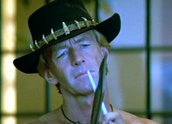
Crocodile Dundee II (1988)
Synopsis
Mick Dundee (Paul Hogan) is living in New York with his new girlfriend, Sue Charlton (Linda Kozlowski). He misses the Northern Territory but keeps occupied by fishing in the Hudson River with sticks of dynamite. Sue’s ex-husband, a reporter (Dennis Boutsikaris), mails her a roll of film, just before he is killed by drug dealers in Colombia. Drug lord Luis Rico (Hechter Ubarry) abducts Sue, but Mick joins forces with his friend Leroy Brown (Charles Dutton) to rescue her. In order to protect her, Mick takes Sue back to the Northern Territory. The drug-dealers follow, assisted by local criminal Frank (Gus Mercurio). Mick takes Sue into the back country, where he’s able to pick off the bad guys one by one, using all his bush skills and ingenuity, and a little help form his old mate Walter Reilly (John Meillon).
Curator’s notes
Not surprisingly, the second instalment of the most successful movie comedy ever made in Australia – and the most successful movie comedy ever made outside America – follows the pattern of the first, but in reverse. Mick has, to an extent, been tamed by domestic life in New York with Sue. When danger threatens, he takes the battle back to the outback, to fight on his home ground. In a way, he reasserts his ‘wildness’ and his masculinity, and a lot of the scenes are consciously built around that idea. In clip one, he’s shown without a shirt, sharpening his knife, beneath ‘primitive’ masks from Papua New Guinea. He’s becoming a Tarzan-like warrior again, as we see him deal with one of Rico’s incapable henchmen.
The second movie asserts more stridently than the first the theme of the ‘white Aboriginal person’. Wally tells his captors that Dundee is more like an Aboriginal man than a white man – he was adopted by Aboriginal people and he has gone through their initiation. Wally laughs when he tells them some people say he talks to the animals, then the film shows him doing it, when he calls the wild bats in to attack Rico’s camp. The mysticism is partly tongue-in-cheek, but not completely so. Part of what local audiences responded to in the character may have been the sense of legitimacy that Mick Dundee offers for white Australia – a sense that we can become adapted to the land like Aboriginal people, that we can have a place in the landscape.
That question of legitimacy is one of the key themes of our cinema, going back to the earliest films. In the 1930s it was an assertion – we can tame the land, as in On Our Selection or Tall Timbers. It was a central question in much of Charles Chauvel’s work. In the Crocodile Dundee films, it’s a different kind of assertion; we can only live on the land if we learn from it, like the blackfella. If we can’t tame the land, we must become ‘wild’ within it. Mick Dundee asserts his right to the land by growing out of it, rather than by conquest. The argument can be seen as a more ecological view of the future of white Australia, or perhaps an assertion of white land rights. That Hogan was thinking about this question was obvious from a scene in the first movie, where Mick describes the land rights debate as ‘like two fleas fighting over the same dog’).
The film was directed by John Cornell, Hogan’s business partner since his earliest days in television comedy (Cornell played ‘Strop’, a dimwitted bloke in a lifesaver cap, in the TV shows). He was producer on the original film, which was directed by Peter Faiman. The script for the second film was by Hogan and his son, Brett. The sequel was hugely successful, taking more than US $240 million worldwide, but not as popular as the first film (US $360 million worldwide).
See more from Crocodile Dundee II on the NFSA website.
- Overview
- Curator’s notes
- Video 1 clip
- Principal credits
- Find a copy
- Make a comment
- Add your review



